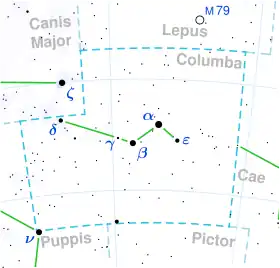HD 34266
HD 34266, also known as HR 1721 is a solitary,[13] yellow hued star located in the southern constellation Columba, the dove. It has an apparent magnitude of 5.73,[2] making it faintly visible to the naked eye under ideal conditions. Based on Gaia DR3 parallax measurements, the object is located 539 light years away.[1] It appears to be drifting away from the Solar System, having a heliocentric radial velocity of 13.2 km/s.[6]
 | |
| Observation data Epoch J2000 Equinox J2000 | |
|---|---|
| Constellation | Columba |
| Right ascension | 05h 14m 28.84578s[1] |
| Declination | −35° 58′ 37.1904″[1] |
| Apparent magnitude (V) | 5.73±0.01[2] |
| Characteristics | |
| Evolutionary stage | Red giant branch[3] |
| Spectral type | G8 III[4] |
| B−V color index | +1.01[5] |
| Astrometry | |
| Radial velocity (Rv) | 13.2±2.9[6] km/s |
| Proper motion (μ) | RA: +11.005 mas/yr[1] Dec.: +13.944 mas/yr[1] |
| Parallax (π) | 6.046 ± 0.0316 mas[1] |
| Distance | 539 ± 3 ly (165.4 ± 0.9 pc) |
| Absolute magnitude (MV) | −0.16[7] |
| Details[8] | |
| Mass | 3.42±0.14 M☉ |
| Radius | 16.2±0.4 R☉ |
| Luminosity | 144±4 L☉ |
| Surface gravity (log g) | 2.68±0.12 cgs |
| Temperature | 4,970±49 K |
| Metallicity [Fe/H] | +0.04±0.04 dex |
| Rotational velocity (v sin i) | 2.3±1.2[9] km/s |
| Age | 490[10] Myr |
| Other designations | |
| Database references | |
| SIMBAD | data |
This is an evolved giant star that is currently on the red giant branch,[3] fusing hydrogen in a shell around an inert helium core. It has a stellar classification of G8 III.[4] HD 34266 is calculated to be 490 million years old,[10] almost 10 times younger than the Sun. However, it already left the main sequence due to a mass of 3.42 M☉.[8] HD 34266 has expanded to 16.2 times the Sun's girth and now radiates 144 times the luminosity of the Sun from its photosphere at an effective temperature of 4,970 K.[8] HD 34266 has a near solar metallicity and spins modestly with a projected rotational velocity of 2.3 km/s.[9]
References
- Vallenari, A.; et al. (Gaia collaboration) (2023). "Gaia Data Release 3. Summary of the content and survey properties". Astronomy and Astrophysics. 674: A1. arXiv:2208.00211. Bibcode:2023A&A...674A...1G. doi:10.1051/0004-6361/202243940. S2CID 244398875. Gaia DR3 record for this source at VizieR.
- Høg, E.; Fabricius, C.; Makarov, V. V.; Urban, S.; Corbin, T.; Wycoff, G.; Bastian, U.; Schwekendiek, P.; Wicenec, A. (March 2000). "The Tycho-2 catalogue of the 2.5 million brightest stars". Astronomy and Astrophysics. 355: L27–L30. Bibcode:2000A&A...355L..27H. ISSN 0004-6361.
- Jones, M. I.; Jenkins, J. S.; Rojo, P.; Melo, C. H. F. (December 2011). "Study of the impact of the post-MS evolution of the host star on the orbits of close-in planets: I. Sample definition and physical properties⋆⋆⋆". Astronomy & Astrophysics. 536: A71. arXiv:1110.6459. Bibcode:2011A&A...536A..71J. doi:10.1051/0004-6361/201117887. ISSN 0004-6361.
- Houk, N. (1982). Michigan Catalogue of Two-dimensional Spectral Types for the HD stars. Volume III: Declinations −40° to −26°. Bibcode:1982mcts.book.....H.
- Johnson, H. L.; Mitchell, R. I.; Iriarte, B.; Wisniewski, W. Z. (1 January 1966). "UBVRIJKL Photometry of the Bright Stars". Communications of the Lunar and Planetary Laboratory. 4: 99–110. Bibcode:1966CoLPL...4...99J.
- Gontcharov, G. A. (November 2006). "Pulkovo Compilation of Radial Velocities for 35 495 Hipparcos stars in a common system". Astronomy Letters. 32 (11): 759–771. arXiv:1606.08053. Bibcode:2006AstL...32..759G. doi:10.1134/S1063773706110065. eISSN 1562-6873. ISSN 1063-7737. S2CID 119231169.
- Anderson, E.; Francis, Ch. (May 2012). "XHIP: An extended hipparcos compilation". Astronomy Letters. 38 (5): 331–346. arXiv:1108.4971. Bibcode:2012AstL...38..331A. doi:10.1134/S1063773712050015. eISSN 1562-6873. ISSN 1063-7737. S2CID 119257644.
- Ottoni, G.; Udry, S.; Ségransan, D.; Buldgen, G.; Lovis, C.; Eggenberger, P.; Pezzotti, C.; Adibekyan, V.; Marmier, M.; Mayor, M.; Santos, N. C.; Sousa, S. G.; Lagarde, N.; Charbonnel, C. (January 2022). "CORALIE radial-velocity search for companions around evolved stars (CASCADES): I. Sample definition and first results: Three new planets orbiting giant stars". Astronomy & Astrophysics. 657: A87. arXiv:2201.01528. Bibcode:2022A&A...657A..87O. doi:10.1051/0004-6361/202040078. eISSN 1432-0746. ISSN 0004-6361.
- De Medeiros, J. R.; Alves, S.; Udry, S.; Andersen, J.; Nordström, B.; Mayor, M. (January 2014). "A catalog of rotational and radial velocities for evolved stars". Astronomy & Astrophysics. 561: A126. arXiv:1312.3474. Bibcode:2014A&A...561A.126D. doi:10.1051/0004-6361/201220762. eISSN 1432-0746. ISSN 0004-6361.
- Dotter, Aaron; Chaboyer, Brian; Jevremović, Darko; Kostov, Veselin; Baron, E.; Ferguson, Jason W. (September 2008). "The Dartmouth Stellar Evolution Database". The Astrophysical Journal Supplement Series. 178 (1): 89–101. arXiv:0804.4473. Bibcode:2008ApJS..178...89D. doi:10.1086/589654. eISSN 1538-4365. ISSN 0067-0049.
- Gould, Benjamin Apthorp (1878). "Uranometria Argentina : brillantez y posicion de las estrellas fijas, hasta la septima magnitud, comprendidas dentro de cien grados del polo austral : con atlas". Resultados del Observatorio Nacional Argentino. 1. Bibcode:1879RNAO....1.....G.
- "HR 1721". SIMBAD. Centre de données astronomiques de Strasbourg.
- Eggleton, P. P.; Tokovinin, A. A. (11 September 2008). "A catalogue of multiplicity among bright stellar systems". Monthly Notices of the Royal Astronomical Society. 389 (2): 869–879. arXiv:0806.2878. Bibcode:2008MNRAS.389..869E. doi:10.1111/j.1365-2966.2008.13596.x. eISSN 1365-2966. ISSN 0035-8711.